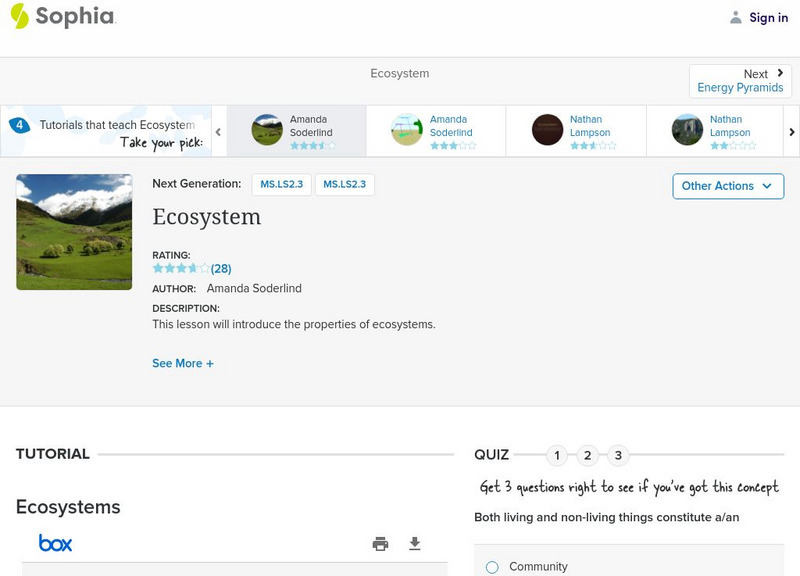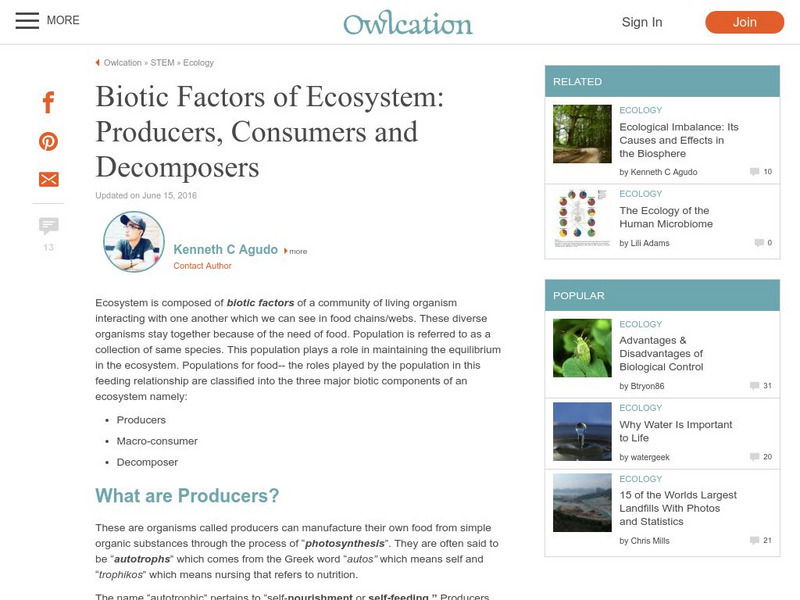Sophia Learning
Sophia: Abiotic and Biotic Factors: Lesson 4
This lesson will introduce abiotic and biotic factors, giving examples and comparing/contrasting the two. It is 4 of 4 in the series titled "Abiotic and Biotic Factors."
Sophia Learning
Sophia: Abiotic and Biotic Factors: Lesson 1
This lesson will introduce abiotic and biotic factors, giving examples and comparing/contrasting the two. It is 1 of 4 in the series titled "Abiotic and Biotic Factors."
Sophia Learning
Sophia: Ecosystem
A PowerPoint giving a basic definition of an ecosystem. Also explained with a definition and examples are abiotic and biotic factors of the ecosystem.
PBS
Pbs Teachers: Canyonlands: Tonight Our Guest Is
This lesson will help students understand that animals adapt to abiotic and biotic conditions in their environment, some of which have evolved over a long period of time through the process of natural selection, and identify the...
Huntington Library
Huntington Library: Making Community Measurements: Abiotic Factors [Pdf]
A lesson plan in which students explore plant communities and observe different types of soil and weather conditions in an attempt to determine cause and effect relationships. Includes discussion questions, extension activities and web...
Huntington Library
Huntington Library: Making Community Measurements: Biotic Factors [Pdf]
A lesson plan in which students explore plant communities and observe and classify different types of vegetation. Includes discussion questions, extension activities and web links, a vocabulary glossary, and handouts.
National Geographic
National Geographic: Ocean Abiotic Factors
Students define and provide examples of abiotic and biotic factors of different ecosystems. Then they investigate the importance of abiotic factors and physical processes within ocean ecosystems.
Science Education Resource Center at Carleton College
Serc: Investigating the Long Meadow Lake Unit of Valley Nat'l Wildlife Refuge
This is a field investigation at the Bass Ponds Trailhead area in the MN Valley National Wildlife Refuge in which middle schoolers will collect data in the field and samples to test back in the classroom. Students will try to elicit the...
Other
Digital Library for Earth System Education: Teaching Box: Seasonal Upwelling
A suite of lessons focusing on the process of upwelling. Inquiry-based exploration of seasonal upwelling includes marine food webs, food production in the ocean, wind-driven ocean currents, and seasonal changes in biotic and abiotic...
National Geographic
National Geographic: Symbiotic Relationships in Marine Ecosystems
In this lesson students analyze videos to make observations about species, populations, and communities of organisms and discuss their symbiotic relationships. Then they create a hypothetical marine ecosystem and describe the adaptive,...
National Center for Ecological Analysis and Synthesis, University of California Santa Barbara
Kids Do Ecology: Learn About Ecology
This resource provides information about ecology.
E-learning for Kids
E Learning for Kids: Science: Marshall Islands: How Can We Tell Living Things From Non Living Things?
Andrea lives on the Marshall Islands, and she will teach you about living and nonliving things.
TeachEngineering
Teach Engineering: How Fast Can a Carrot Rot?
Students conduct experiments to determine what environmental factors favor decomposition by soil microbes. They use chunks of carrots for the materials to be decomposed, and their experiments are carried out in plastic bags filled with...
Other
Hub Pages: Abiotic Factors: A Component of Ecosystem
In the environment, there are external factors that really affect organisms living within it. One of these factors is the set of abiotic factors, or nonliving variables, such as wind, ocean, day length, rainfall, temperature, and ocean...
Science Struck
Science Struck: Abiotic Factors of the Rainforest
Abiotic factors, e.g., sunlight and precipitation, play a huge role in supporting biodiversity in a rainforest. This article discusses the features of rainforests and how abiotic factors affect the plants and animals that live there.
Other
Hub Pages: Biotic Factors of Ecosystem: Producers, Consumers and Decomposers
An ecosystem is composed of biotic factors of a community of living organisms interacting with one another which we can see in food chains/webs. These diverse organisms stay together because of the need of food. Population is referred to...
Scholastic
Scholastic: Study Jams! Science: Ecosystems
A video and a short multiple-choice quiz on the topic of ecosystems, covering biotic and abiotic factors, and the roles organisms play in an ecosystem.
Utah Education Network
Uen: Habitat Alterations of a Riparia
This field trip is designed to physically immerse students in the concept of habitat alteration focusing on biotic and abiotic habitat alterations.
Texas Instruments
Texas Instruments: Glencoe Middle School Science: Biodiversity and Ecosystems
Students will conduct a field investigation to learn about the environment. They will observe biotic and abiotic factors of an ecosystem. Students can use the CBL 2 and a temperature probe to collect data and a graphing calculator to...
Khan Academy
Khan Academy: What Is Ecology?
A webpage giving an overview of ecology. Learn about the biotic and abiotic factors that make up an ecosystem as well as the different levels of ecology.
BBC
Bbc: Gcse Bitesize: Adaptations, Interdependence and Competition Aqa
The abundance and distribution of organisms in an ecosystem is determined by biotic and abiotic factors. Animals and plants have adaptations to allow them to compete for resources.
Sophia Learning
Sophia: Ecosystem: Lesson 1
This lesson will introduce the properties of ecosystems. It is 1 of 4 in the series titled "Ecosystem."
University of Michigan
University of Michigan: The Concept of the Ecosystem
Lesson looks at the definition of an ecosystem, biogeochemical cycles, and factors responsible for the differences between ecosystems.
Oswego City School District
Regents Prep: Ecosystems/communities
Abiotic factors vary in the environment and determining the types and numbers of organisms that exist in that environment. Factors which determine the types and numbers of organisms of a species in an ecosystem are called limiting...
Other popular searches
- Biotic Abiotic
- Biotic and Abiotic Factors
- Biotic and Abiotic
- Abiotic Biotic Environment
- Abiotic and Biotic Elements
- Abiotic and Biotic Resources
- Biotic Abiotic Factors
- Abiotic Biotic Lab
- Ecosystems Abiotic Biotic
- Biotic Abiotic Pictures
- Biotic Abiotic Piotures
- Biotic or Abiotic Changes






![Huntington Library: Making Community Measurements: Abiotic Factors [Pdf] Lesson Plan Huntington Library: Making Community Measurements: Abiotic Factors [Pdf] Lesson Plan](https://d15y2dacu3jp90.cloudfront.net/images/attachment_defaults/resource/large/FPO-knovation.png)














